Desert locust
Introduction
The Desert Locust (Schistocerca gregaria) is a species of short-horned grasshopper in the family Acrididae. It is one of the most destructive migratory pests in the world, capable of causing significant damage to crops and pastures due to its voracious appetite and ability to form dense swarms. The desert locust is found primarily in Africa, the Middle East, and Asia, inhabiting an area of about 16 million square kilometers, or 30% of the Earth's land surface[1].

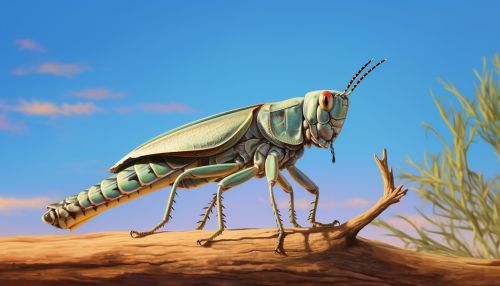
Biology and Behaviour
Desert locusts exhibit a fascinating and complex array of biological and behavioural characteristics. They have a unique ability to switch between two distinct phases – the solitary phase and the gregarious phase – in response to changes in population density and environmental conditions[2].
Solitary Phase
In the solitary phase, desert locusts lead a relatively quiet life. They are cryptically coloured, usually brown or green, which helps them blend in with their surroundings and avoid predators. Solitary locusts avoid each other and have a low metabolic rate, which is advantageous in the harsh desert environment where food is often scarce[3].
Gregarious Phase
When conditions are favourable, and locust populations increase, they can switch to the gregarious phase. Gregarious locusts are brighter in colour, often yellow and black, and exhibit a much higher metabolic rate. They form dense, mobile swarms that can contain billions of individuals and cover hundreds of square kilometers[4].

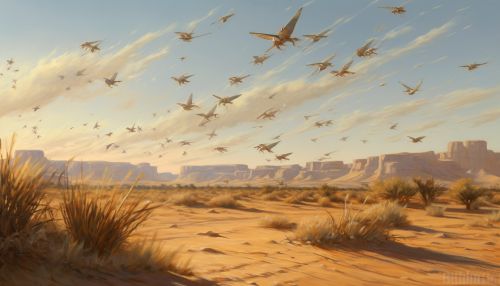
Life Cycle
The life cycle of the desert locust consists of three stages: egg, nymph, and adult. The duration of each stage can vary greatly depending on environmental conditions, particularly temperature and humidity[5].
Egg Stage
Female locusts lay their eggs in the soil, usually in areas of damp sand or loam. The eggs are laid in pods, each containing up to 100 eggs. The egg stage can last from 10 to 65 days, depending on temperature and moisture conditions[6].
Nymph Stage
The nymph stage, or hopper stage, is the second stage of the desert locust's life cycle. Hoppers resemble small, wingless adults. They undergo five moults before reaching the adult stage, with each moult called an instar. The nymph stage can last from 20 to 40 days[7].
Adult Stage
Adult desert locusts are strong fliers. They can travel great distances and can cover up to 150 km in a day. Adults can live up to three months, and females can lay up to three batches of eggs in their lifetime[8].
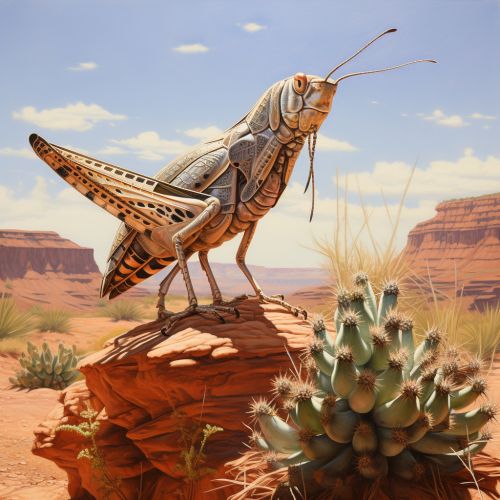
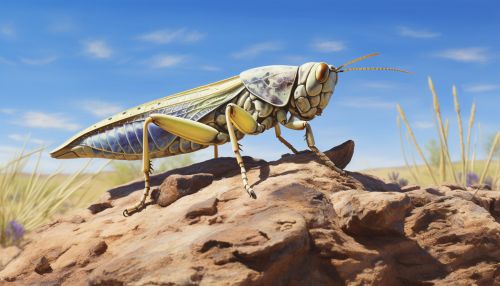
Impact on Agriculture
Desert locusts pose a significant threat to agriculture due to their ability to form large swarms and their voracious appetite. A small swarm can consume the same amount of food in one day as about 35,000 people. In areas where agriculture is crucial for local and national economies, locust invasions can cause devastating losses and contribute to food insecurity[9].
Control Measures
Controlling desert locust populations is a challenging task due to their mobility and the vast area they inhabit. The primary method of control is the use of chemical pesticides, applied by vehicle-mounted and aerial sprayers. However, these methods have raised environmental and health concerns. As a result, research into more sustainable and environmentally friendly control methods, such as biological pesticides and habitat management, is ongoing[10].

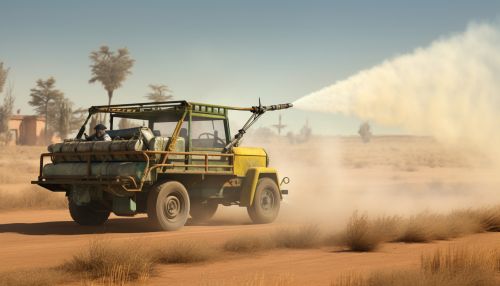
See Also
References
- ↑ FAO. (2020). Desert Locust. Food and Agriculture Organization of the United Nations. Retrieved from http://www.fao.org/ag/locusts/en/info/info/index.html
- ↑ Roessingh, P., Simpson, S. J., & James, S. (1998). The Mechanism of Phase Change in Locusts: A Review. Physiological Entomology, 23(4), 281-295. doi:10.1111/j.1365-3032.1998.tb01547.x
- ↑ Uvarov, B. P. (1977). Grasshoppers and Locusts. Vol. 2. Centre for Overseas Pest Research, London, UK.
- ↑ Chapuis, M. P., Loiseau, A., Michalakis, Y., Lecoq, M., Franc, A., & Estoup, A. (2009). Outbreaks, gene flow and effective population size in the migratory locust, Locusta migratoria: a regional-scale comparative survey. Molecular Ecology, 18(5), 792-800. doi:10.1111/j.1365-294X.2008.04040.x
- ↑ Launois, M., Launois-Luong, M. H., & Lecoq, M. (1998). The locusts: biology of a plague. Centre de coopération internationale en recherche agronomique pour le développement (CIRAD).
- ↑ FAO. (2020). Desert Locust. Food and Agriculture Organization of the United Nations. Retrieved from http://www.fao.org/ag/locusts/en/info/info/index.html
- ↑ Launois, M., Launois-Luong, M. H., & Lecoq, M. (1998). The locusts: biology of a plague. Centre de coopération internationale en recherche agronomique pour le développement (CIRAD).
- ↑ FAO. (2020). Desert Locust. Food and Agriculture Organization of the United Nations. Retrieved from http://www.fao.org/ag/locusts/en/info/info/index.html
- ↑ FAO. (2020). Desert Locust. Food and Agriculture Organization of the United Nations. Retrieved from http://www.fao.org/ag/locusts/en/info/info/index.html
- ↑ FAO. (2020). Desert Locust. Food and Agriculture Organization of the United Nations. Retrieved from http://www.fao.org/ag/locusts/en/info/info/index.html
